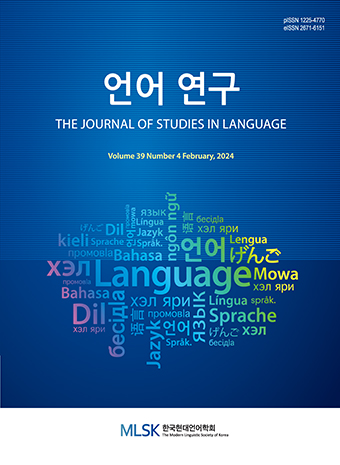Research Article
Abstract
References
Information
This paper examines how Kyungsang speakers utilize acoustic cues to identify the word-initial oral and nasal stops using acoustically-manipulated stimuli in the perception test. The results show that F0 is a major acoustic cue for distinguishing between nasal and tense stops and between lax and aspirated stops and that VOT is a major cue for identifying tense stops but not for lax or aspirated stops. 92% of nasals are correctly identified even without their consonantal nasal portion and 98% of nasals are perceived as tense stops only from raising F0 of the following vowel. The results are consistent with Ahn(2019)’s study on Seoul speakers.
- Ahn, M.-J. 2013. Acoustic Duration of Korean Nasals. Studies in Phonetics, Phonology and Morphology 19, 411-31. 10.17959/sppm.2013.19.3.411
- Ahn, M.-J. 2019. Effects of F0 and VOT on the Identification of Korean Word-Initial Oral and Nasal Stops. The Journal of Linguistic Science 90, 203-18. 10.21296/jls.2019.9.90.203
- Chen, M. and H. Clumeck. 1975. Denasalization in Korean: A Search for Universals. In C. A. Gerguson, L. M. Hyman and John. J.
- Kang, K.-H. and S. Guion. 2008. Clear Speech Production of Korean Stops: Changing Phonetic Targets and Enhancement Strategy. JASA 124.6, 3909-17. 10.1121/1.2988292 19206816
- Kang, Y. 2014. Voice Onset Time Merger and Development of Tonal Contrast in Seoul Korean Stops: A Corpus Study. Journal of Phonetics 45, 76-90. 10.1016/j.wocn.2014.03.005
- Kenji, Y. 1998. Korean Denasalization and Sentence Construction, Shoin Review, 12, 167-187 (in Japanese).
- Kenji. Y. 2008. Phonetic Implementation of Korean Denasalization and its Variation Related to Prosody. IULC Working Papers Online 8.1.
- Kenstowicz, M. and C. Park. 2006. Laryngeal Features and Tone in Kyungsang Korean: A Phonetic Study. Studies in Phonetics, Phonology and Morphology 12, 247-64.
- Kim, M.-R., P. Beddor, and J. Horrocks. 2002. The Contribution of Consonantal and Vocalic Information to the Perception of Korean Initial Stops. Journal of Phonetics 30.1, 77-100. 10.1006/jpho.2001.0152
- Kim, M.-R. 2012. Tonogenesis in Korean: Some Recent Speculations on the Sound Change. Korea Journal of Linguistics 37.2, 243-83. 10.18855/lisoko.2012.37.2.001
- Kim, Y. 2011. An Acoustic, Aerodynamic and Perceptual Investigation of Word-Initial Denasalization in Korean. Ph.D. diss, University of College London.
- Lee, H. and A. Jongman. 2012. Effects of Tone on the Three-way Laryngeal Distinction in Korean: An Acoustic and Aerodynamic Comparison of the Seoul and South Kyungsang Dialects. Journal of the International Phonetic Association 42, 145-169. 10.1017/S0025100312000035
- Lee, H. and A. Jongman. 2015. Acoustic Evidence for Diachronic Sound Change in Korean Prosody: A Comparative Study of the Seoul and South Kyungsang Dialects. Journal of Phonetics 50, 15-33. 10.1016/j.wocn.2015.01.003
- Lee, H. and A. Jongman. 2018. Effects of Sound Change on the Weighting of Acoustic Cues to the Three-way Laryngeal Stop Contrast in Korean: Diachronic and Dialectal Comparisons. Language and Speech. Published online. 10.1177/0023830918786305 30014745
- Martin, S. 1951. Korean Phonemics. Language 27, 519-33. 10.2307/410039
- Ohala, J. 1997. Emergent stops. Proceedings of the 4th Seoul International Conference of the Phonetic Society of Korea. Seoul: Phonetic Society of Korea.
- Silva, D., Y. Choi, and J. Kim. 2004. Evidence of a Diachronic Shift in the VOT Values of Korean Stop Consonants. Harvard Studies in Korean Linguistics 10, 173-85.
- Silva, D. 2006. Acoustic Evidence for the Emergence of Tonal Contrast in Contemporary Korean. Phonology 23, 287-308. 10.1017/S0952675706000911
- Umeda, H. 1989. Korean Language. The Sanseido Encyclopedia of Linguistics, Sanseido (in Japanese).
- Umeda, H. 1957. The Phonemic System of Modern Korean. Journal of Linguistic Society of Japan 32, 60-82.
- Yoo, K. 2015. Domain-Initial Denasalization in Busan Korean: A Cross-Generational Case Study. Proceedings of the 18th International Congress of Phonetic Sciences.
- Yoo, K. and F. Nolan. 2020. Sampling the Progression of Domain-Initial Denasalization in Seoul Korean. Laboratory Phonology: Journal of the Association for Laboratory Phonology 11, 1-32. 10.5334/labphon.203
- Publisher :The Modern Linguistic Society of Korea
- Publisher(Ko) :한국현대언어학회
- Journal Title :The Journal of Studies in Language
- Journal Title(Ko) :언어연구
- Volume : 37
- No :3
- Pages :307-316
- DOI :https://doi.org/10.18627/jslg.37.3.202111.307




 The Journal of Studies in Language
The Journal of Studies in Language






